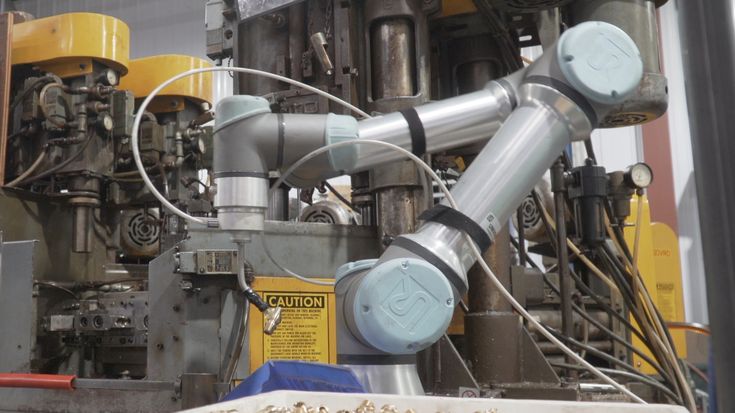

Family-owned business cuts costs by automating bin picking
In short
Flywheel Automates Multiple Machine Tending and Welding Tasks Using ActiNav Bin Picking and UR5 Cobot Flywheel Supply is a family-owned machine shop that produces about 29,000 unique metal parts for antique machinery, steam and boiler controls, valves, and gauges, for both industrial and government applications. The company moves a single UR5 cobot between an ActiNav automated bin picking application for machine tending and TIG welding applications to drive productivity and help the company compete nationally and globally.
The business transformation
Flywheel’s high-mix, low-volume production made it difficult to cost-effectively automate many processes such as repetitive, manual machine tending and welding tasks—especially with no prior robotics experience. Additional challenges for the machine tending application included parts that are oily from upstream machine processes, making them difficult for a robot to accurately pick and place, but a wash station between processes would add costs and delays.
Flywheel Supply
The solution
A single UR5 cobot is easily moved between machines and processes to automate multiple tasks, including machine tending and welding. The ActiNav UR+ Application Kit for flexible machine loading automates a wide range of processes, such as drilling, chamfering, and threading parts without needing a wash station between processes. The ActiNav application will ultimately process 1,500 different part numbers.
“The only way that made sense for us to put a robot on a machine tending application was to be able to do randomized bin picking,” says Zach Northway, Flywheel co-owner and lead project engineer. “The cycle times on the machine are so short that if an operator has to stand there and line parts up in an organized fashion for a robot to pick them in a traditional sense, it would defeat the entire purpose of using the robot to begin with, because your operator is still standing there.”
Zach Northway, co-owner, Flywheel SupplyPrior to the robot, we were averaging about a minute cycle time for a person to weld them manually. With the robot doing the TIG welding, you simply drop the parts in the fixture, clamp it down and hit start, and it welds that part now in 14 seconds. Our throughput is four to five times greater than having one person welding continuously.

Automating pick and place
In Flywheel’s ActiNav application, the UR5 cobot picks parts from a deep bin and places them in the jaws of a machine that indexes to multiple stations to perform multiple tasks such as drilling, chamfering, and internal and external threading. Ultimately, the ActiNav system will process as many as 1,500 different part numbers, so it must be quickly programmable to pick parts of different shapes, sizes, and weights. “The biggest advantage to ActiNav is that it can take randomization of parts being dumped in a bin, and as the bin gets low, a person can just come by and dump some more into the bin and it will keep picking parts,” explains Northway. “It doesn’t have to be reset, recalibrated—anything. It notices the bin amount changed and it keeps on going.”

Working together
The UR cobot uses a vacuum gripper to pick up each part. ActiNav verifies pick success and the cobot presents the part to the integrated scanner to ensure that the part is correctly oriented before placing it in the machine. Because the parts are oily and can easily shift position, ActiNav does validation checks throughout the routine to verify placement and make sure the robot precisely hits the target in the angle and position required. If the image sensor recognizes that a part has changed position, making it unplaceable, the cobot drops the part into a reject bin. During the course of the day, an operator empties the rejected parts back into the bin, where ActiNav can re-pick them successfully the next time.

Straightforward integration
With a fast-moving, high-mix manufacturing environment, Flywheel has also deployed the UR cobot without the ActiNav kit in TIG welding applications. Northway found the integration with the welder to be a straightforward process. “One of the really nice advantages of the UR robot and the software is you’re able to take a CAD file and output a G-code tool path like you would use on a mill,” he says. “The robot will follow that tool path and give you really good, precise control over where your welds end up going on your part.”

Operating 24 hours a day
The biggest cost savings of the cobot will be that it can run lights-out, 24 hours a day without stopping, and will therefore be able to outperform a human who can only work eight hours a day. And that one person that used to run that machine can now become a more-skilled, higher-paid, more-diverse worker who can tend robots, program robots, and fix robots; set up other machines; and maybe babysit a work cell with four or five applications when they used to only be able to do one, says Northway.
Automation challenges solved:
Single robot can be flexibly redeployed Fits in tight production environment Increases production hours without increasing staff
Key value drivers:
Complete kit for bin picking application Easy to program Increased welding throughput by 4 to 5 times Reduced welding cycle time from one minute to 14 seconds part-to-part Lightweight and flexible to easily move and redeploy Employees moved from repetitive manual processes to higher-value roles
Tasks solved by collaborative robots:
ActiNav flexible machine loading can work around the clock, picking randomized parts from a deep bin and accurately placing them for a range of processes Fast implementation for TIG and MIG welding applications, with easy reprogramming
Get in touch with Universal Robots
Thousands of businesses rely on Collaborative Robots to...
- Increase productivity
- Adapt to changing product demand
- Improve employee well-being and retention
- Staff through labor shortages
- Universal Robots USA, Inc
- 27175 Haggerty Road, Suite 160
- 48377 Novi, MI